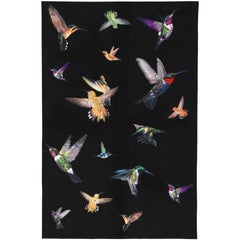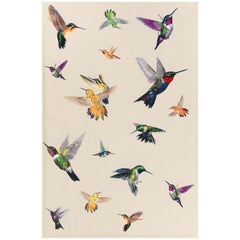Alexander Mcqueen Hummingbirds
Recent Sales
21st Century and Contemporary Nepalese Modern Western European Rugs
Silk
21st Century and Contemporary Nepalese Modern Western European Rugs
Silk
Alexander McQueen for sale on 1stDibs
British fashion designer Lee Alexander McQueen, the original creative engine behind the Alexander McQueen label, was beloved for his expert tailoring and theatrical runway shows. After his suicide in 2010, fans left tributes to the man and his talents outside Alexander McQueen boutiques worldwide. Record-breaking crowds visited the posthumous retrospective of the designer’s work at the Metropolitan Museum of Art in New York City and the Victoria and Albert in London.
The inspirations for vintage Alexander McQueen bags, dresses, jackets and other items came from many quarters — film, music, current events, history, his heritage and fashions of the past. The designer's runway presentations were not just displays of clothing but were personal expressions of the zeitgeist, often touching on our cultural anxieties and concerns. McQueen’s own thoughts and feelings about love, death, gender, genocide, colonialism, global warming and the extinction of species all appear in his pieces.
McQueen certainly shook up fashion; he was a born Rottweiler. His upbringing on a council estate in north London played a part, but his family was close and supportive, not dysfunctional. He was proud of his Scottish heritage: He was a defiant fashion warrior. His historical themes and shows — such as “Highland Rape,” 2002, which was inspired by England’s “rape of Scotland,” as McQueen called it — always invoked powerful reactions from his audience of fashion pros.
“What you see in the work is the person himself. And my heart is in my work,” McQueen told Harper’s Bazaar in 2007.
It is perhaps this heart, and the heart’s exposure, that drew the crowds and made McQueen's creations both popular and emotionally resonant. Because the work was personal and thus layered with feeling, the motifs — decorative embellishments and fabric choices — have meaning. In other words, in McQueen’s oeuvre, plaid is more than simply a pattern.
Find vintage Alexander McQueen fashion and accessories — including the designer's coveted bags and comfortable, stretchy jersey knit dresses and gowns — on 1stDibs.
A Close Look at Modern Furniture
The late 19th and early 20th centuries saw sweeping social change and major scientific advances — both of which contributed to a new aesthetic: modernism. Rejecting the rigidity of Victorian artistic conventions, modernists sought a new means of expression. References to the natural world and ornate classical embellishments gave way to the sleek simplicity of the Machine Age. Architect Philip Johnson characterized the hallmarks of modernism as “machine-like simplicity, smoothness or surface [and] avoidance of ornament.”
Early practitioners of modernist design include the De Stijl (“The Style”) group, founded in the Netherlands in 1917, and the Bauhaus School, founded two years later in Germany.
Followers of both groups produced sleek, spare designs — many of which became icons of daily life in the 20th century. The modernists rejected both natural and historical references and relied primarily on industrial materials such as metal, glass, plywood, and, later, plastics. While Bauhaus principals Marcel Breuer and Ludwig Mies van der Rohe created furniture from mass-produced, chrome-plated steel, American visionaries like Charles and Ray Eames worked in materials as novel as molded plywood and fiberglass. Today, Breuer’s Wassily chair, Mies van der Rohe’s Barcelona chair — crafted with his romantic partner, designer Lilly Reich — and the Eames lounge chair are emblems of progressive design and vintage originals are prized cornerstones of collections.
It’s difficult to overstate the influence that modernism continues to wield over designers and architects — and equally difficult to overstate how revolutionary it was when it first appeared a century ago. But because modernist furniture designs are so simple, they can blend in seamlessly with just about any type of décor. Don’t overlook them.
Finding the Right Rugs-carpets for You
Good antique rugs and vintage rugs have made their way into homes across the globe, becoming fixtures used for comfort, prayer and self-expression, so choosing the right area rug is officially a universal endeavor.
In modern usage, “carpet” typically denotes a wall-to-wall floor cushioning that is fixed to the floor. Rugs, on the other hand, are designed to cover a specific area and can easily be moved to new locations. However, the terms are interchangeable in many parts of the world, and, in the end, it won’t matter what you decide to call it.
It’s well known that a timeless Persian rug or vintage Turkish rug can warm any interior, but there are lots of other styles of antique rugs to choose from when you're endeavoring to introduce fresh colors and textures to a bedroom or living room.
Moroccan Berber rugs are not all about pattern. In fact, some of the most striking examples are nearly monochrome. But what these rugs lack in complexity, they make up for in brilliant color and subtle variation. Moroccan-style interiors can be mesmerizing — a sitting room of this type might feature a Moroccan rug, carved wooden screens and a tapestry hung behind the sofa.
Handwoven kilim rugs, known for their wealth of rich colors and unique weaving tradition, are pileless: Whereas the Beni Ourain rugs of Morocco can be described as dense with a thick surface or pile, an authentic kilim rug is thin and flat. (The term “kilim” is Turkish in origin, but this type of textile artistry is practiced all across the Balkans, throughout the Arab world and elsewhere.)
When it comes to eye-catching floor coverings, the distinctive “medallion” pattern of Oushak rugs has two types of rounded shapes alternating against a rich red or blue background created with natural dyes, while the elaborate “star” pattern involves large eight-pointed shapes in diagonal rows alternating with diamonds.
If you’re looking for something unexpected, find a runner rug that pops in your hallway or on your stairs. Dig for dazzling geometric patterns in our inventory of mid-century modern rugs and carpets, which includes works designed by the likes of Swedish textile masters Märta Måås-Fjetterström, Marianne Richter and other artisans.
Carpets and rugs have been around for thousands of years. Prehistoric humans turned to animal skin, wool and fur to craft simple fabrics to soften hard terrain. A 2016 study suggests that "cave lions" were hunted for exactly this purpose, and that decorating your cave with their pelts may have conferred strength and prestige. Although many of these early textiles are still in existence, tracing their precise origins is difficult. Carpets quickly became such a valuable trade commodity that the weavings could easily travel far from their places of origin.
The oldest known carpet was found in southern Siberia. (It may have traveled there from Persepolis in Iran.) For the flat-weave floor rugs crafted by Native Americans, cotton was the primary material before sheep’s wool was introduced in the 16th century. In Europe, carpet-making was fundamental to folk art, and Asian carpets imported to European countries were at one time considered a precious luxury and not intended to remain permanently on the floor.
With the variety of area rugs and carpets rolled out for you on 1stDibs — a collection that includes traditional, modern, minimalist rugs and other coverings of all kinds — things will be looking up whenever you’re looking down.
- 1stDibs ExpertOctober 15, 2024To tell if an Alexander McQueen dress is real, look at the brand label tag inside the neck. Counterfeiters often make mistakes in copying the font style, character size and spacing. You can often spot fakes by comparing labels to images of authentic tags shared on trusted online resources. Next, look carefully at the seams along the hemline, sleeves, waist and other areas. Uneven, loose or misaligned stitching will usually indicate a replica. If you have any lingering doubts about the authenticity of your dress, consult a certified appraiser or expert authenticator. On 1stDibs, find a large selection of Alexander McQueen dresses.
- 1stDibs ExpertMarch 22, 2022Alexander McQueen fashions, shoes and accessories have a signature style that is eclectic. The brand borrows elements from the Roman, Gothic and Victorian eras and frequently incorporates dark colors, heavy fabrics and romantic embellishments like lace. Its skull-patterned scarves and oversized sneakers are among their most well-known designs. Find a large selection of Alexander McQueen on 1stDibs.
- What is Alexander McQueen?1 Answer1stDibs ExpertMarch 22, 2022Alexander McQueen is a luxury fashion brand founded by a designer by the same name. The fashion house designs haute couture and prêt-à-porter clothing for men and women, as well as shoes, handbags, accessories and jewelry. Shop a large selection of Alexander McQueen on 1stDibs.
- 1stDibs ExpertMarch 22, 2022Alexander McQueen often incorporated natural materials into his designs. Examples include hair, feathers, coral, shells and wood. Tweed is a signature material for many fashions, and the brand's scarves tend to feature airier fabrics like silk and chiffon. You'll find a collection of Alexander McQueen on 1stDibs.
- 1stDibs ExpertApril 5, 2022Alexander McQueen’s last collection was the Fall/Winter 2010 collection, which was nearly finished at the time of his death. This collection was presented at Paris Fashion Week after his passing. Find a range of authentic Alexander McQueen products from top boutiques worldwide on 1stDibs.
- 1stDibs ExpertFebruary 21, 2024Where Alexander McQueen t-shirts are made varies. Many tees produced by the British luxury fashion house come from factories in Italy. However, others are manufactured in Turkey and in factories in Asia. Generally, tees made outside of Italy are a part of the McQ diffusion line. Explore a variety of Alexander McQueen shirts on 1stDibs.
- 1stDibs ExpertMarch 22, 2022Many things inspired Alexander McQueen's designs. The fabrics and styles of traditional clothing worn in India, Africa, Turkey, China and Japan served as sources of inspiration. Music, film, theater, the natural world and the designer's own Scottish heritage also influenced his work. Explore a large collection of Alexander McQueen on 1stDibs.

